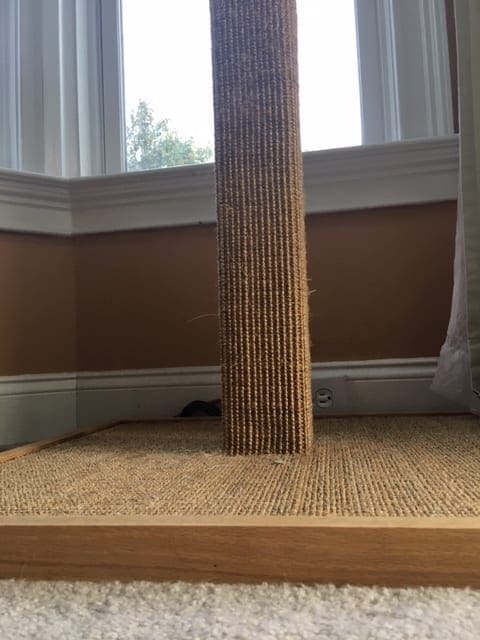Listen to the audio version of this article

If you don’t want your cat scratching the furniture, you’ll need to provide an object more appealing. When I say appealing, I’m not referring to whether your cat likes the way it looks – I’m referring to whether it gets the job done or not. The only reason your cat may decide to scratch on the furniture instead of the post is because the furniture meets his needs. If the post you provided looks pretty but isn’t effective from a cat’s point of view then it’ll just sit in the corner and gather dust.
There are three must-have basics when it comes to a scratching post:
The Scratching Post Must Have an Appealing Texture
Many of the cheap posts you find in your local pet supply store are covered in carpet. Pretty to look at, soft to touch, but totally ineffective when it comes to scratching. The post needs to have a rough texture that will allow the cat to rake his nails across the surface. When a cat scratches, he wants to dig his nails into the object’s surface in order to remove the outer dead nail sheath. If the post is covered in carpet, chances are all that will happen is the cat’s nails will get stuck in the carpet loops. That’s a sure way to drive him back to scratching on your sofa again.
So when it comes to texture, think rough and not soft loopy carpet covering. Overall, sisal is typically the best choice. It’s rough, it’s durable and the cat can get an effective and satisfying scratch.
Even though most cats prefer the sisal covering, there are some cats who have other preferences. If your cat doesn’t like sisal you can try other rough materials. Some cats even prefer to scratch on bare wood. I know of several cats who go crazy for tree bark when it comes time to scratch, so if you don’t mind the mess, bring in a few logs for the cat to scratch on.
Corrugated cardboard is another popular scratching material so if you happen to have a cat who likes to scratch horizontally, consider getting a few corrugated cardboard scratching pads.
In general though, sisal is often a pretty sure bet when it comes to what kind of texture kitty prefers.
The Scratching Post Must be Sturdy and Tall
You can get a scratching post that’s covered in the best material but if it’s wobbly or unstable, your cat will head right back to that trusty old sofa for his scratching needs. He has to be able to lean his full weight against the post without having it topple over. Unless you want to actually create an aversion to the scratching post, make sure the post is constructed well.
The height of the post is also important. When you’re dealing with a kitten you can have a shorter post but as your cat grows, he’ll need a post that will allow him to get a full stretch when he reaches up to scratch. Scratching isn’t just about conditioning the nails, it’s also about being able to unkink those muscles and get a full body stretch. Make sure the post you purchase or build is tall enough for the size of your cat. A point to remember: the taller the post, the wider the base. When you get a tall post, the base needs to be wide enough to maintain stability.

Photo: Pam Johnson-Bennett
The Scratching Post Location
I realize that a scratching post, just like the litter box, isn’t one of the most beautiful pieces of equipment when it comes to living with a cat. Although I have seen some very attractive and creative posts in my time, I recognize it’s a natural tendency to want to hide it in the corner. Wrong! The post should be placed where the cat likes to scratch.If you’re retraining a cat who is currently scratching a piece of furniture then the post should be placed right next to that object. Make it as convenient as possible for your cat to recognize the better option you’ve provided for him.
Pay attention to your cat’s scratching habits so you’ll know where to locate the post. Some cats like to scratch after a nap or after a meal. Others scratch when in a tense situation or as a way to displace anxiety. Locate the post where you think your cat would appreciate it most. And you don’t have to limit yourself to one scratching post. I have one cat and we have three scratching posts located throughout the house (not to mention a couple of cat trees). This way, my cat can scratch near where she prefers to nap, near her favorite playtime area and also in the living room where she used to prefer scratching on my sofa.
If you have more than one cat you’ll need more than one scratching post. Even though you can’t dedicate a particular post to a certain cat, you can offer choice and that’s a crucial component in maintaining multicat harmony.
Need More Information?
For more information on cat behavior and training, refer to the best-selling books by Pam Johnson-Bennett. Pam’s books are available at bookstores and online. We’ve included Amazon links here on our website.
If you have a question about your cat’s behavior or health, contact your veterinarian. This article is not intended as a medical diagnosis nor is it a replacement for your cat’s regular veterinary care. This article is for general information purposes only.




